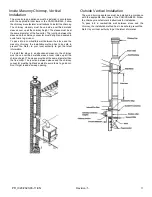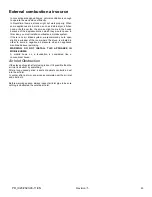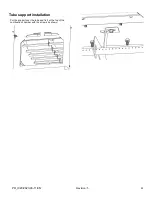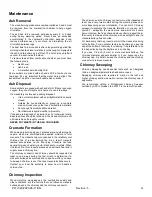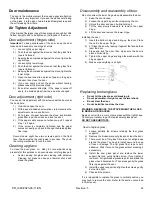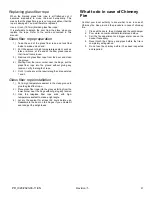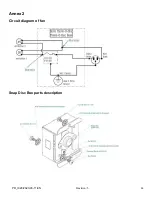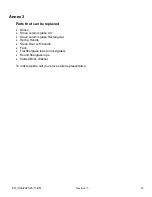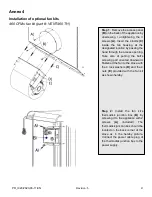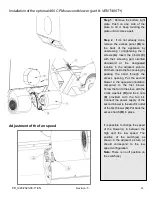
PR_I020/2023-08-11-EN
Revision: 5
24
Even if this nuisance is temporary, open the windows and the
doors in order to ensure a good ventilation. This special paint
is conceived to tolerate temperatures until 1200°F (650°C).
Keep a fire
To add firewood into the stove and keep a fire:
1) Turn the handle to horizontal position and wait a few second
to let the fire adjusting to the new conditions.
2) Open the door handle to the first position and wait a few
second to balance pressure to avoid fume to escape from
stove.
3) Turn the handle completely and leave the door half open
and leave the time so that the fire can adjust.
4) Open the door widely.
5) Move embers with poker near the door to oxygen it and
make it burned completely.
5) Add firewood over the ember, keeping it away from the
glass door to prevent the flame from touching the ceramic
glass.
ATTENTION:
DO NOT CHARGE THE STOVE OVER THE HEIGHT OF
THE BRICKS.
DO NOT BUILD A FIRE TOO CLOSE TO THE DOOR
GLASS.
YOUR APPLIANCE IS CONCEIVED FOR BURNING CORD
WOOD. ANY OTHER KIND OF WOOD IS NOT
RECOMMENDED.
7) Close the door slightly and let the wood burn.
8) Once the fire becomes stable, close and lock the door.
9) Adjust the air admission handle to desired setting.
NEVER LEAVE THE STOVE UNATTENDED WHEN THE
DOOR IS SIGHTLY OPEN. ALWAYS CLOSE THE DOOR
AFTER ADDING A LOAD. Keeping the door open is not
advised. When the appliance is heated, sparks may come
out of the hearth. A fire runaway may be created causing
the appliance and flue pipes to overheat.
NEVER USE ANY INFLAMABLE LIQUID TO REVIVE THE
FIRE.
Fans Controls
When it’s on, the fan goes off at the temperature of ventilation
box getting higher than 120 Fahrenheit (49 degree Celsius).
NEVER ROUTE THE ELECTRIC WIRE OF FANS IN FRONT
OR UNDER APPLIANCE.
Fuel Selection
This heater is designed to burn only firewood. Using firewood
dried properly results in higher efficiencies and lower
emissions of pollutant compared with using softwood or fresh
wood.
Moisture Meter Information
Firewood is ready to use at 10
‐
25% moisture content.
Fresh cut logs can have a moisture content of 80% or more,
depending on species. During the drying process, wood might
shrink, split, twist or change shape. In general, wood must be
dried before use. Air drying, i.e. ‘seasoning’ is the most
common method used for cordwood.
Season wood outdoors through the summer for at least 6
months before burning it. Properly seasoned wood is darker,
has cracks at the ends, and sounds hollow when smacked
against another piece of wood.
In most parts in the North America, the minimum moisture
content that can be generally obtained in air drying is about 12
to 15 percent.
Things not to burn
"Never use gasoline, gasoline-type lantern fuel, kerosene,
charcoal lighter fluid, or similar liquids to start or 'freshen up' a
fire in this heater. Keep all such liquids well away from the
heater while it is in use."
−
Garbage;
−
Lawn clippings or yard waste;
−
Materials containing rubber, including tires;
−
Materials containing plastic;
−
Waste containing petroleum products, paints or paint
thinners, or asphalt products;
−
Materials containing asbestos;
−
Construction or demolition debris;
−
Railroad ties or pressure-treated wood;
−
Manure or animal remains;
−
Salt water driftwood or other previously salt water
saturated materials;
−
Unseasoned wood;
−
Paper products, cardboard, plywood, or particleboard.
The prohibition against burning these materials does not
prohibit the use of fire starters made from paper, cardboard,
saw dust, wax and similar substances for the purpose of
starting a fire in an affected wood heater. Burning these
materials may result in release of toxic fumes or render the
heater ineffective and cause smoke.
Wood storage
The cordwood must be stored in a dry place, away from rain
and snow.
It should not be stored under the stove or too close to it.
If any wood is stored next to the stove, you must respect the
minimum clearances to avoid self-ignition.
- 10 inches (25.4 cm) rear
- 20 inches (50.8 cm) side
- 48 inches (122 cm) loading door
Draft
Draft is the force which moves air from the appliance up
through the chimney. The amount of draft in your chimney
depends on its length, local geography, nearby obstructions
and other factors. Too much draft may cause excessive
temperatures in the appliance and may damage the appliance.
An uncontrollable burn or excessive temperature indicates
excessive draft.
Insufficient draft will cause the appliance to leak smoke into the
room through appliance and chimney connector joints.
Summary of Contents for ULTIMATE TOR 2015
Page 4: ...PR_I020 2023 08 11 EN Revision 5 4 Rating plate...
Page 5: ...PR_I020 2023 08 11 EN Revision 5 5 Appliance Dimension...
Page 13: ...PR_I020 2023 08 11 EN Revision 5 13 Firebox configuration and part list...
Page 28: ...PR_I020 2023 08 11 EN Revision 5 28 Annex 1 Door assembly Square Door Arc Door...








